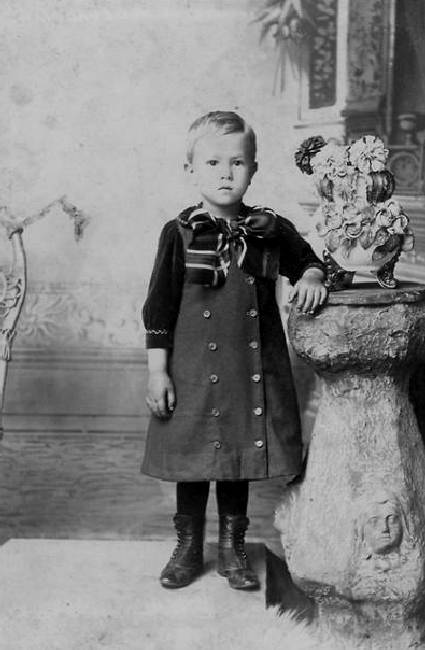
American Boy Dresses: Styles--Waist Treatment

Figure 1.--This boy is unidentifiedm but looks to be about 3-4 years old. All we know for sure is that he was from Evansville, Indiana. We wouldf guess it was taken in the 1880s. The bow in particular looks to be from the 1880s or early 90s. The boy looks to be wearing a A-Line pinafore dress without a waistline. I think the sleeves are a blouse and not part of the dress, but here we are unsure.
|
|
One important feature of a dress is the waistline. The waistline can be used to categorize many dresses. We note dresses made with both defined waists and dresses made without waists. Of course there are many other features of a dress, but the waistline treatment is one of the principal features. I do not know if there were any gender connotations concerning the two types of dresses. Many dresses had defined waislines. This was the more common approach to the waist in garment desisn. The waisline treatment varied over time and thus can be useful in fating old photographs. The waisline treatment was done in a variety of ways. Our archive is not yet large enough to assess any such connotations. Nor do we know yet how these different styles varied over time. But we hope to gradually develop information on dress waistimes. Another aspect of the waist treatment n dresses iswhere the waislkine is position. The stndard position is of course at or near the waist, but there were other tions and the popularity of these options varied over time. Dress makers were always experimentng with vatious options. And we note dresses with high bodice/skirt divisions and low bodice/skirt divisions mean high and low sett waists. The empire dresses of the early-19th century had very high waists. And we note that low waists became popular after mid-century.
Definition
Undefined Waistlines
We begin to have large numbers of images of boys wearing dresses in the mid-19th century with the development of photography. One of the dress styles that we see at mid-century is a shirt-light dress that did not end at the waist but just continued to knee level or lower. A good example is an unidentified boy about 1850. This was a less common fdress type than defined-waist dresses, but it is a style that we do note.
Many dresses had defined waislines. This was the more common approach to the waist in garment desisn. The waisline treatment varied over time and thus can be useful in fating old photographs. The waisline treatment was done in a variety of ways. One common approach was to vary the bodice above the waistline with the skirt below the waistline. This can be done in a number of ways. Approaches included decoration like smocking on the bodice or different materials or pleating on the skirt below the waistine. The placement of the waistlinr also varied. Of coutse it would be commonly be placed at the waistline. But here placement varied stylistically. We have noted dresses with waislines both below and above the child's actual waisline.
Position
Another aspect of the waist treatment n dresses iswhere the waislkine is position. The stndard position is of course at or near the waist, but there were other tions and the popularity of these options varied over time. Dress makers were always experimentng with vatious options. And we note dresses with high bodice/skirt divisions and low bodice/skirt divisions mean high and low sett waists. The empire dresses of the early-19th century had very high waists. And we note that low waists became popular after mid-century. A good example is a dfress looking somewhat like a kilt suit worn by Maurice Frost about 1880.
HBC

Navigate the Historic Boys' Clothing Web dress pages:
[Return to the Min U.S. dress cnstructin elemet page]
[Return to the Main U.S. national dress/kilt style page]
[Return to the Main U.S. national dress style page]
[Pinafores]
[Ringlet curls]
[Smocks]
[Bodice kilts]
[Kilts]
[Fauntleroy dresses]
[Sailor dresses]
[Fancy dresses]
[Dresses: 16th-18th centuries]
[Dresses: Early-Mid-19th century]
[Dresses: Late-19th century]
[Dresses: Early 20th century]
[Difficult images]
[Movie dresses]
Navigate the Boys' Historical Clothing Web Site:
[Introduction]
[Activities]
[Biographies]
[Chronology]
[Clothing styles]
[Countries]
[Bibliographies]
[Contributions]
[Essays]
[FAQs]
[Glossaries]
[Images]
[Links]
[Registration]
[Tools]
[Boys' Clothing Home]
Created: 7:00 PM 11/11/2006
Last updated: 9:25 AM 8/13/2014



